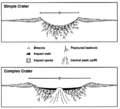Manicouagan crater
| Manicouagan crater | |
|---|---|
 The crater in winter, photographed by Space Shuttle mission STS-9 in 1983 (north is to the lower right). | |
| Impact crater/structure | |
| Confidence | confirmed[1] |
| Diameter | 100 kilometres (62 mi) |
| Age | 214 ± 1 million years old (Triassic Period) |
| Exposed | Yes |
| Drilled | Yes |
| Location | |
| Location | Rivière-aux-Outardes / Rivière-Mouchalagane, Quebec |
| Coordinates | 51°23′N 68°42′W / 51.383°N 68.700°WCoordinates: 51°23′N 68°42′W / 51.383°N 68.700°W |
| Country | Canada |
 Manicouagan crater Location of the Manicouagan crater in Quebec
| |
| Topo map | Canada NTS 22N |
| Access | Quebec Route 389 |
The Manicouagan Crater is one of the oldest known impact craters and is the largest 'visible' impact crater on Earth, located primarily in Manicouagan Regional County Municipality in the Côte-Nord region of Québec, Canada,[1] about 300 km (190 mi) north of the city of Baie-Comeau. At roughly 213-215 million years old, Manicouagan is one of the oldest large astroblemes still visible on the surface. Its northernmost part is located in Caniapiscau Regional County Municipality. It is thought to have been caused by the impact of a 5 km (3 mi) diameter asteroid about 215.5 million years ago (Triassic Period).[2] It was once thought to be associated with the end-Carnian extinction event.
The crater is a multiple-ring structure about 100 km (60 mi) across, with its 70 km (40 mi) diameter inner ring its most prominent feature; it contains a 70 km (40 mi) diameter annular lake, the Manicouagan Reservoir, surrounding an inner island plateau, René-Levasseur Island. It is the earth's sixth-largest confirmed impact crater according to rim-to-rim diameter.[3]
Hypothetical multiple impact event
It has been suggested that the Manicouagan crater may have been part of a multiple impact event which also formed the Rochechouart crater in France, Saint Martin crater in Manitoba, Obolon' crater in Ukraine, and Red Wing crater in North Dakota. Geophysicist David Rowley of the University of Chicago, working with John Spray of the University of New Brunswick and Simon Kelley of the Open University, discovered that the five craters formed a chain, indicating the breakup and subsequent impact of an asteroid or comet,[4] similar to the well observed string of impacts of Comet Shoemaker-Levy 9 on Jupiter in 1994.
Kelley had developed a technique to precisely date impact craters, using laser argon-argon dating of the glass formed by the impacts, and cited stratigraphic evidence to support an older age of 215 million years (Late Triassic). He and Kelley sought Rowley's help to determine how the craters were aligned when the impacts occurred, since—due to plate tectonics—the locations have moved large distances in the intervening 214 million years. Three of the craters—Rochechouart, Manicouagan and Saint Martin—formed a 5,000 km (3,100 mi) chain at latitude 22.8° N, while Obolon' and Red Wing lay on identical declination paths with Rochechouart and Saint Martin respectively. All of the craters had previously been known and studied, but their paleoalignment had never before been demonstrated. Rowley has said that the probability that these craters could be aligned like this due to chance is nearly zero.[5]
See also
Notes
- ↑ 1.0 1.1 "Manicouagan". Earth Impact Database. University of New Brunswick. Retrieved 2009-08-19.
- ↑ Ramezani, J., S. A. Bowring, M. S. Pringle, F. D. Winslow, III, and E. T. Rasbury (2005). "The Manicouagan impact melt rock: a proposed standard for intercalibration of U-Pb and 40Ar/39Ar isotopic systems". 15th V.M. Goldsmidt Conference Abstract Volume, p. A321.
- ↑ "Impact Structures listed by Diameter (Increasing)". PASSC. Retrieved 6 July 2012.
- ↑ Spray, J.G., Kelley, S.P. and Rowley, D.B. (1998). "Evidence for a late Triassic multiple impact event on Earth". Nature, v. 392, pp. 171-173. Abstract
- ↑ Steele, Diana (19 March 1998). "Crater chain points to impact of fragmented comet". University of Chicago Chronicle
External links
- Aerial exploration of the Manicouagan crater.
- Rowley, David. "Paleogeographic Atlas Project: Pictures". Paleogeographic Atlas Project. University of Chicago. Archived from the original on 18 June 2007. Retrieved 14 June 2013.

